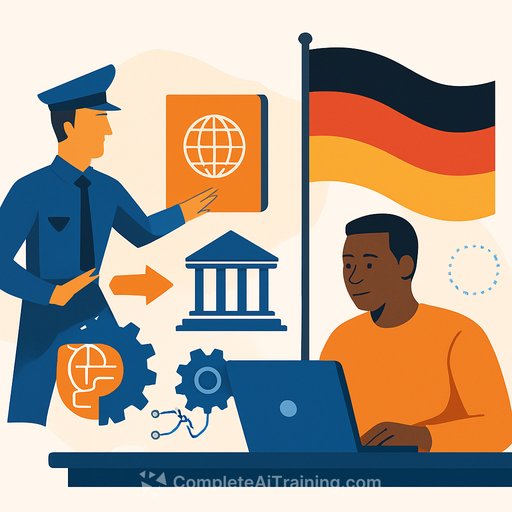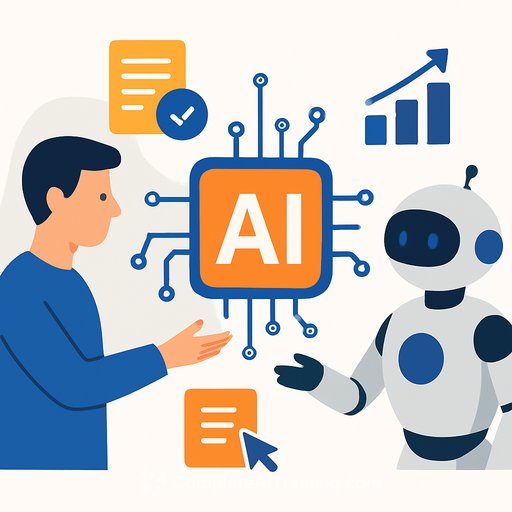Germany's AI push: what it means for your agency
Germany's federal government has put AI at the core of its "Modernization Agenda." The goals are direct: reduce bureaucracy costs by 25% by 2029, move more public services online, and deploy AI across administration and courts.
The plan adds concrete use cases: an online platform to centralize export rules and credit options, and AI-assisted visa processing to accelerate document review. It builds on the "High-Tech Agenda," which names AI among six priority technologies alongside biotechnology and microelectronics.
The plan at a glance
- Administrative efficiency: 25% bureaucracy cost reduction target by 2029.
- Digital services: More services online, fewer in-person bottlenecks.
- AI in core workflows: Courts, visas, export support, and internal ops.
- Infrastructure push: A federal mandate to improve lagging digital capacity.
A visible signal: the "Weimatar" minister avatar
The state is also test-driving AI in public communication. An AI avatar of State Minister for Culture and Media Wolfram Weimer, the "Weimatar," can speak 100 languages. It aims to broaden reach and cut production time for internal training videos, with an explicit goal of fair AI that protects creativity and public discourse.
What experts endorse - and what they challenge
Germany's leading AI researchers urge policymakers to be guided by science, not industry agendas. The message is simple: government has a moral duty to follow competent advice, especially when public money and rights are at stake.
They also caution that generative AI tools can be over-generalized and unreliable. For government, the higher return likely comes from process optimization and problem-specific models rather than general chatbots. That's where time, accuracy, and cost improvements compound.
Where AI is already earning its keep
- Federal/state firms: Deutsche Bahn and other public entities are using AI assistants in daily workflows.
- Baden-Württemberg: Tools for text streamlining, a city chatbot in Ludwigsburg, and use of ChatGPT to "optimize public administration."
- Cologne: Pilot for city planning and traffic management.
- Munich: Route optimization for garbage collection.
- Heidelberg: Early disease detection pilots in hospitals.
Rights, risk, and the line you cannot cross
Legal scholars and ethicists agree: AI can assist with preliminary checks and standard cases, but human review is essential in atypical matters and wherever fundamental rights are in play. That applies to healthcare, justice, and immigration in particular.
Data protection is non-negotiable. Germany's strict rules align with the EU's GDPR: data minimization, strict retention limits, and user rights to access, correction, and deletion. See the European Commission's overview of GDPR principles here: EU Data Protection.
Procurement and sovereignty
A newly announced OpenAI-SAP cooperation spotlights a key issue: dependency on external vendors and unclear data flows. The question for public buyers is simple: who sees your data, for what purpose, and under what exit terms?
- Demand clarity: Data access, retention, model training rights, and auditability.
- Insist on portability: Exit clauses, data export formats, and migration support.
- Prefer sovereignty: EU-hosted options, transparent model cards, and on-prem or VPC paths for sensitive workloads.
- Balance risk: Use non-sensitive pilots with third-party models; keep high-risk workloads on controlled infrastructure.
For public reference on the partnership context, see SAP's newsroom: SAP News.
How to make it work: a 90-day public-sector playbook
- Pick 2-3 use cases with measurable value: e.g., document triage for visas, case routing in social services, or scheduling optimization.
- Run small, safe pilots: Synthetic or anonymized data first; expand only after passing accuracy, bias, and security gates.
- Build an AI review board: Legal, IT, business owners, data protection officers, and labor representatives.
- Set guardrails: Human-in-the-loop, audit logs, model cards, DPIAs, fallback procedures, and issue escalation.
- Measure what matters: Cycle time reduction, error rate, case throughput, citizen satisfaction, and cost per case.
- Train your teams: Prompts for productivity, verification habits, and data hygiene. Create quick-reference SOPs.
- Communicate early: Explain scope, safeguards, and recourse; publish impact reports to earn trust.
Generative AI hype vs. practical gains
Critics argue Berlin risks chasing hype while practical fixes wait. The pragmatic path prioritizes workflow-specific models, back-office automation, and decision support that reduces queues and errors. Save the headline experiments for low-risk domains; focus your budget where outcomes are measurable.
What to keep front and center
- People: human oversight in edge cases and rights-sensitive decisions.
- Process: simplify steps before automating them.
- Proof: pilots with clear KPIs and independent evaluation.
- Privacy: data minimization and strict retention by default.
- Portability: avoid lock-in; keep exit options real.
Upskilling for government teams
Most gains will come from staff who can spot automation opportunities and validate outputs. If you need structured learning paths by role, explore curated options here: AI courses by job.
Bottom line
Germany is moving fast on AI in public service. The promise is real if agencies focus on process-level wins, human oversight, and data stewardship. Build for trust, measure impact, and keep control over your infrastructure and vendors.
Your membership also unlocks:






